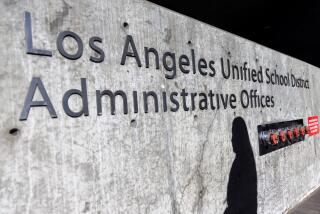Providing Safe Passage : LAPD’s Crossing Guard Volunteers Give Schools and Students an Assist
- Share via
NORTH HOLLYWOOD — Assistant Principal Rosalba Manrique was shocked when she came to Fair Avenue Elementary school two years ago and saw small children darting in and out between cars as impatient parents honked their way through busy intersections after school.
“I walked out and started stopping traffic with my bare hands,” Manrique said Wednesday, standing on the corner of Kittridge Street and Fair Avenue, where four volunteer guards now help children and parents cross the street. “Can you imagine this without guards?”
Manrique started contacting city and police officials, and last year her school joined Safe Crossings, a program sponsored by the Los Angeles Police Department. Today, 16 volunteers help the school’s 1,800 students safely cross streets, and a second group of volunteers will be trained this fall.
In an effort to bring hundreds of volunteer crossing guards to elementary schools that do not qualify for paid guards, Councilmen Mike Feuer and Mike Hernandez and officials with the Los Angeles Unified School District announced Wednesday--the district’s first day of the 1999-2000 school year--plans to expand the Safe Crossing program citywide.
Only about 60% of the city’s elementary schools have full-time crossing guards provided by the city Department of Transportation.
Safe Crossings was started last year to train parents and others to serve as crossing guards at neighborhood schools. About 20 schools currently participate in the program.
“Securing school intersections with volunteer crossing guards is a terrific solution to this problem,” Feuer said. “The Safe Crossings program worked well. But until now it’s only been available at a handful of schools.”
Since it costs about $15,000 a year to staff an intersection, the city Department of Transportation pays for guards at only 262 of the 450 public elementary schools in Los Angeles.
A new intersection rating system and an anticipated infusion of funds should raise the number slightly, but nearly 100 schools that want crossing guards have been turned down, district officials said.
About 130 schools have expressed interest in the Safe Crossing program, according to a survey conducted over the summer, said Joe Nardulle, a school traffic specialist for the district.
To be eligible, schools need to have applied for a paid crossing guard and been turned down. Then they can apply to the LAPD, which will train volunteers.
“Up until now, it’s just been a very localized and ad hoc phenomenon,” said Daniel Hinerfeld, a spokesman for Feuer. “What’s different now is that there has been a commitment on the part of LAPD to come up with resources necessary to do training, and on the part of the city to provide liability.”
Besides recruiting the volunteers, schools have to supply vests, stop signs and traffic cones. The city’s Volunteer Bureau will provide liability insurance.
Nardulle did not know how many injuries or accidents had occurred near schools or whether the rate of accidents dropped with the addition of guards. But Safe Crossings schools noticed not only an improvement in children’s safety, but in the behavior of drivers around the campuses, he said.
“When you are a motorist driving to work in a hurry, and you see your neighbor helping kids cross the street, that makes you drive more carefully,” Nardulle said.
On Wednesday, at Fair Avenue Elementary, hundreds of students streamed off campus after the last bell rang at 2:28 p.m.
A line of cars stretched outside. Some parents yelled at the crossing guards, and fidgety kids bounced on the curb, eager to cross, while guards held them back.
The guards walked authoritatively to the center of the street, raised their stop signs and the students surged across.
Leticia Toledo has a daughter who graduated from Fair Avenue Elementary two years ago, but she still volunteers as a guard because she lives in the neighborhood.
“I saw a lot of problems here, with kids crossing the street,” she said. “Now, they wait. At first, they tried to run, at any moment. But little by little, they understand what they need to do.”
Less than two miles away, at Oxnard Street School, cars and trucks zoomed by on the four-lane road.
Principal Kathleen O’Driscoll said her school qualified for one paid guard on Oxnard Street but since 70% of her 1,250 students walk to school, she says the school could use more help. O’Driscoll said she may apply to the Safe Crossing program.
“We are still working on it,” she said. “The city put in what they are calling a smart crosswalk--it has sensors to show when a pedestrian is waiting, but we have just one guy.”
More to Read
Sign up for Essential California
The most important California stories and recommendations in your inbox every morning.
You may occasionally receive promotional content from the Los Angeles Times.













